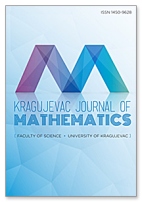Bi-Periodic Hyper-Fibonacci Numbers
 Download PDF
Download PDF
Authors: N. BELAGGOUN AND H. BELBACHIR
DOI: 10.46793/KgJMat2504.603B
Abstract:
In the present paper, we introduce and study a new generalization of hyper-Fibonacci numbers, called the bi-periodic hyper-Fibonacci numbers. Furthermore, we give a combinatorial interpretation using the weighted tilings approach and prove several identities relating these numbers. Moreover, we derive their generating function and new identities for the classical hyper-Fibonacci numbers.
Keywords:
Hyper-Fibonacci numbers, bi-periodic Fibonacci numbers, bi-periodic hyper-Fibonacci numbers, generating function.
References:
[1] T. Amdeberhan, X. Chen, V. H. Moll and B. E. Sagan, Generalized Fibonacci polynomials and Fibonomial coefficients, Ann. Comb. 18(4) (2014), 541–562. https://doi.org/10.1007/s00026-014-0242-9
[2] M. Bahşi, I. Mezö and S. Solak, A symmetric algorithm for hyper-Fibonacci and hyper-Lucas numbers, Ann. Math. Inform. 43 (2014), 19–27.
[3] H. Belbachir and A. Belkhir, Combinatorial expressions involving Fibonacci, hyper-Fibonacci, and incomplete Fibonacci numbers, J. Integer Seq. 17(4) (2014), Article ID 14.4.3.
[4] H. Belbachir and A. Belkhir, On generalized hyper-Fibonacci
and incomplete Fibonacci polynomials in arithmetic progresions,  iauliai Math. Semin. 11(19) (2016), 1–12.
iauliai Math. Semin. 11(19) (2016), 1–12.
[5] H. Belbachir and F. Bencherif, On some properties of bivariate Fibonacci and Lucas polynomials, J. Integer Seq. 11(2) (2008), Article ID 08.2.6.
[6] A. T. Benjamin and J. J. Quinn, Proofs that Really Count: The Art of Combinatorial Proof, Volume 27, The Mathematical Associationof America, Washington, DC, 2003.
[7] A. T. Benjamin, J. J. Quinn and F. E. Su, Phased tilings and generalized Fibonacci identities, Fibonacci Quart. 38(3) (2000), 282–288.
[8] G. Bilgici, Two generalizations of Lucas sequence, Appl. Math. Comput. 245 (2014), 526–538. https://doi.org/10.1016/j.amc.2014.07.111
[9] N. N. Cao and F. Z. Zhao, Some properties of hyperfibonacci and hyperlucas numbers, J. Integer Seq. 13(8) (2010), Article ID 10.8.8, 1–11.
[10] A. Dil and I. Mezö, A symmetric algorithm for hyperharmonic and Fibonacci numbers, Appl. Math. Comput. 206(2) (2008), 942–951. https://doi.org/10.1016/j.amc.2008.10.013
[11] M. Edson, S. Lewis and O. Yayenie, The k-periodic Fibonacci sequence and extended Binet’s formula, Integers 11(A32) (2011), 739–751. https://doi.org/10.1515/INTEG.2011.056
[12] M. Edson and O. Yayenie, A new generalization of Fibonacci sequences and extended Binet’s Formula, Integers 9(A48) (2009), 639–654. https://doi.org/10.1515/INTEG.2009.051
[13] D. Panario, M. Sahin, and Q. Wan, A family of Fibonacci-like conditional sequences, Integers 13(A78) (2013). https://doi.org/10.1515/9783110298161.1042
[14] D. Panario, M. Sahin, Q. Wang and W. Webb, General conditional recurrences, Applied. Math. Comp. 243 (2014), 220–231. https://doi.org/10.1016/j.amc.2014.05.108
[15] J. L. Ramirez, Bi-periodic incomplete Fibonacci sequences, Ann. Math. Inform. 42 (2013), 83–92.
[16] E. Tan, Some properties of the bi-periodic Horadam sequences, Notes Number Theory Discrete Math. 23(4) (2017), 56–65.
[17] S. Uygun and E. Owusu, A new generalization of Jacobsthal numbers (Bi-Periodic Jacobsthal Sequences), J. Math. Anal. 7(5) (2016), 28–39. https://doi.org/10.9734/jamcs/2019/v34i530226
[18] O. Yayenie, A note on generalized Fibonacci sequence, Appl. Math. Comput. 217(12) (2011), 5603–5611. https://doi.org/10.1016/j.amc.2010.12.038
